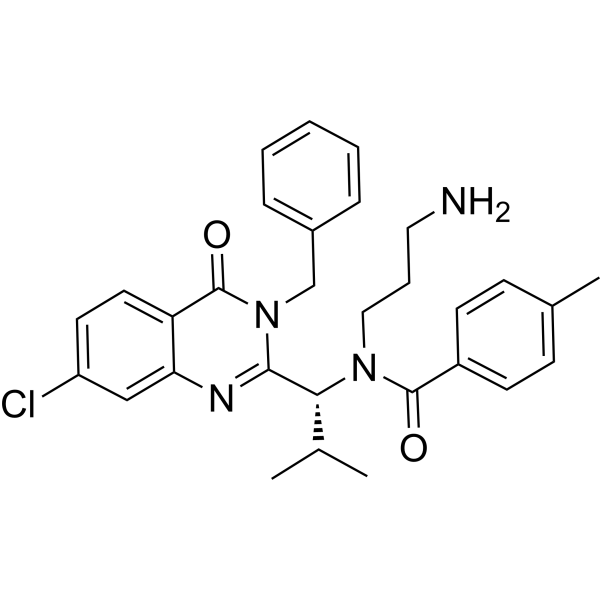Home
Products
Ispinesib (SB-715992)



| Product Name | Ispinesib (SB-715992) |
| Price: | Inquiry |
| Catalog No.: | CN00241 |
| CAS No.: | 336113-53-2 |
| Molecular Formula: | C30H33ClN4O2 |
| Molecular Weight: | 517.06 g/mol |
| Purity: | >=98% |
| Type of Compound: | Alkaloids |
| Physical Desc.: | Powder |
| Source: | |
| Solvent: | Chloroform, Dichloromethane, Ethyl Acetate, DMSO, Acetone, etc. |
| SMILES: | NCCCN([C@@H](c1nc2cc(Cl)ccc2c(=O)n1Cc1ccccc1)C(C)C)C(=O)c1ccc(cc1)C |
| Contact us | |
|---|---|
| First Name: | |
| Last Name: | |
| E-mail: | |
| Question: | |
| Description | Ispinesib is a specific inhibitor of KSP, with a Ki app of 1.7 nM. |
| Target | KSP:1.7 nM (Ki app) |
| In Vitro | Ispinesib is a potent, highly specific inhibitor of KSP, with a Ki app of 1.7 nM[1]. Ispinesib (150 nM) inhibits BT-474 and MDA-MB-468 cell lines, with GI50s of 45 and 19 nM, respectively[2]. Ispinesib (SB715992, 15 and 30 nM) suppresses the proliferation of PC-3 prostate cancer cell by 48.65% and 52.16%, and induces apoptosis of prostate cancer cell by 1094.88% and 1516.70%, respectively. Ispinesib up regulates genes responsible for apoptosis and cell cycle arrest, and down regulates genes responsible for cell proliferation and survival. The anti-proliferation and pro-apoptotic activities of Ispinesib can be enhanced by genistein[3]. |
| In Vivo | Ispinesib (SCID, 8 mg/kg; nude, 10 mg/kg, q4d × 3) reduces tumor volume in mice bearing tumor xenografts of ER-positive (MCF7), HER2-positive (KPL4, HCC1954, and BT-474), and triple-negative (MDA-MB-468) breast cancer cells via i.p. one dose every 4 days repeated three times[2]. |
| Cell Assay | PC-3 prostate cancer cells are seeded in 96 well plates at a density of 4 × 103 cells/well. PC-3 cells are incubated for 24 hours to allow attachment to the surface of each well of the tissue culture plate. Then, the cells are treated with varying concentration of reagents and incubated for 1 to 3 days. First, PC-3 cells are treated with 15 and 30 nM of Ispinesib, respectively. Second, PC-3 cells are subjected to combinational treatments with 7.5 or 10 nM of Ispinesib plus 30 μM of genistein. Finally, PC-3 cells are pre-treated with 30 μM of genistein for 24 hours followed by treatment with 15 nM of Ispinesib. Control cells are treated with 0.3 mM Na2CO3 (vehicle control). After treatment, PC3 cells are incubated at 37°C with MTT (0.5 mg/mL) for 2 hours and isopropyl alcohol at room temperature for 1 hour. The spectrophotometric absorbance of each sample is then determined by using ULTRA Multifunctional Micro Plate Reader at 595 nm[3]. |
| Animal Admin | Mice with a tumor volume of ∼250 mm3 receive a single dose of Ispinesib (10 mg/kg). Tumors are dissected, fixed in 10% buffered formalin, and embedded in paraffin, and 5-μm tissue sections are prepared. Antigen retrieval is done by boiling in 50 mM citrate buffer (pH 5.5), and sections are then incubated in 3% hydrogen peroxide, washed in PBS-0.1% Tween, and blocked in 10% goat serum. Phospho-histone H3 (PH3) antibody is detected using Alexa Fluor 488 secondary antibody. Images are taken with a microscope at ×10 magnification and captured using MetaMorph software to quantify PH3 expression by computing the area ratio of PH3-positive cells per total cells. Ki67/cleaved caspase-3 staining is done. Nonfluorescent images are taken on an Olympus BX41 microscope at ×20 magnification[2]. |
| Density | 1.2±0.1 g/cm3 |
| Boiling Point | 708.0±70.0 °C at 760 mmHg |
| Flash Point | 382.0±35.7 °C |
| Exact Mass | 516.229187 |
| PSA | 81.22000 |
| LogP | 5.20 |
| Vapour Pressure | 0.0±2.3 mmHg at 25°C |
| Storage condition | -20℃ |